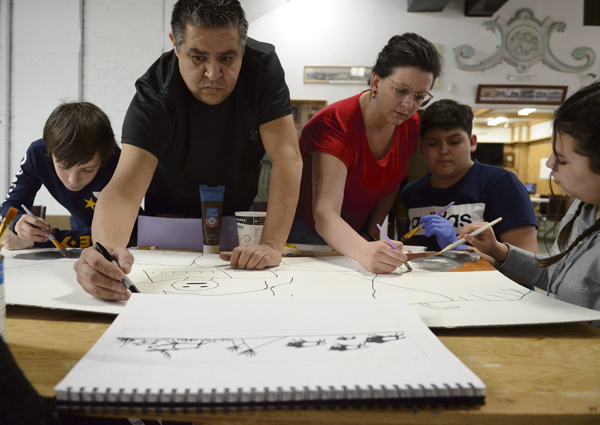
History, art and community are coming together at the Prince Albert Historical Museum this week as members of the public and two Indigenous artists team up to help bring some more colour to the museum’s upcoming Indigenous section.
The project, funded through a handful of grants, is seeing members of the public paint designs drawn out by local Métis artist Leah Dorian and by Saskatoon First Nations artist Kevin Pee Ace. The completed panels will go up in the Connaught Room — the room with the big canoe in it — as part of a new Indigenous exhibit set to open this April.
Monday, Dorion guided a few dozen residents through the painting of a pair of Métis-inspired scenes, while Tuesday, Pee Ace was at the museum as a smaller group painted a panel inspired by the area’s pre-history.
“We’re looking into the archaeological record, and a lot of the material is found in the ground,” Pee Ace said.
“That’s what the focus of today’s panel is. We have images of petroglyphs and images of teepees, buffalo skulls and arrow heads because that is pretty much what they found in the ground before the city was here.”
The families who showed up to help paint were encouraged to use earth tones and were decorating the collage-like design with browns and yellows and oranges and even some deep blues and greens. In a few short minutes, they had already completed one portion of the panel.

Pee Ace was getting some inspiration from a friend he brought with him from Saskatoon, Adrian McKenzie. McKenzie would create a drawing, and then Pee Ace would translate it to the panel, interpreting it in a slightly different style to match the feel he was looking for.
“(McKenzie) does a lot of work, First Nations work in animals and very traditional images as well,” Pee Ace said.
“He’s familiar with a lot of work up north, a lot of the petroglyphs. He’s kind of like an explorer. He’s been up there, he camps out sometimes for months at a time and documents a lot of these hidden sights people aren’t familiar with.”
Petroglyphs are images created by carving into a rock face. Ancient peoples, including Canada’s First Nations, created rock art that has been discovered in locations across the country.
“These come from actual sites, and we have a record of some of these sites,” Pee Ace said.
“It’s necessary to put them in (the panel) because it’s part of the history of the area.”
While the panel painters were working on Tuesday depicts some of the objects found under or in the ground, the theme goes back to the very roots of Prince Albert itself.

“It was a gathering place. This is a celebration of that,” Pee Ace said.
“To have the community represented, at even that far back in time, just to show that there is a long history here. That’s what this panel is.”
Other panels will progress into more recent times, showing some of the traditions of the different First Nations and different cultural groups at the time.
“We will be getting into beadwork, more colours, more designs,” Pee Ace said.
“A lot of the material we have to work with is the artifacts, and the fact that we’re int eh museum works really well to access a lot of that material. When people come into the museum, these are some of the first panels they will see.”
Pee Ace is responsible for the First Nations panels. There will be four of them lined up along one wall. His focus on the museum’s artifacts is a similar approach to the one Dorion used. She incorporated the Métis sash and Métis beadwork patterns into her design.
“The flowers and all of the vine work fits in very well with the beadwork on the artifacts,” said museum curator Michelle Taylor.

“We have an activity where people have to find the beadwork on the pictures and match it to the beadwork in the collection.”
So far, Taylor has been pleased with the community response.
“(Monday) there were 909 people in the museum, and I’m assuming most of them painted. This is the first day with any of the First Nations-themed panels, and it’s a Tuesday of the holiday, s I’m pleased with the number of people here to paint too,” she said.
The artists have embraced the project.
“Both of them have a lot of experience working with the public, so they definitely are teaching people about the project and what is in their pictures, and what that means to their culture,” Taylor said.
The third section of panels will be designed by students from Queen Mary School, and they will be encouraged to incorporate designs showing their own interpretation of Indigenous culture into the artwork.
That section will show “what (the students) understand as their heritage, and what’s important to them about Indigenous ways of life,” Taylor said.
“We want the panels to be meaningful to the people of Prince Albert, and tie the (Indigenous) groups in the area to the artifacts in the museum.”

